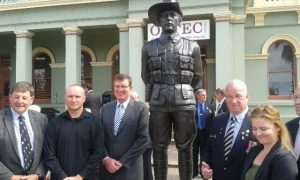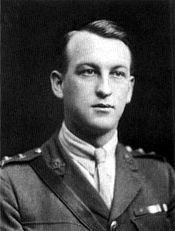John Hamilton was born in Orange on 24 January 1896 to William and Catherine Hamilton. His parents were married on 11 April 1893 in St Joseph’s Roman Catholic Church in Orange. Catherine was the daughter of Ambrose Fox and his wife Ann Elizabeth [nee Frost] who was the eldest daughter of Samuel Frost the Orange brickmaker. Samuel made the bricks for many of the principal buildings of Orange, including the Holy Trinity Church and the Orange Public School.
John and his family were living in Lithgow in 1910 when his mother died. John, age 14, was the eldest of six surviving children. By 1914 John was working as a butcher in his father’s shop at Penshurst in Sydney.
Enlisting on 15 September 1914, he joined the 3rd Battalion, then being formed. He embarked with the unit on 18 October as a Private, and took part in the original landing at Gallipoli on 25 April 1915.
At age 19 John took part in the bloody battle at Lone Pine. Of the 883 officers and men of the 3rd Battalion at the time of the assault, only 291 marched out. Shortly after 4am on 9 August the Turkish troops launched a violent general attack extending over a large part of the front. To counter an assault on the 3rd Battalion headquarters the adjutant Howell-Price instructed six men including Hamilton to get out on the parapet and attack the Turks in the trench and those coming across open ground. Most prominent among the handful of Australian sharp-shooters lying out in the open, John Hamilton’s courage had already been noted during the bitter fighting. He played a key role in the bombing duels which became such a deadly feature of the battle. As well as hurling improvised jam-tin bombs at the Turks, Hamilton picked up enemy bombs and threw them back before they exploded. The extraordinary spirit of the Australian bombers was revealed by Lt. A.F. Burrett: ‘two of my bombers Norton and Hamilton – the latter won his VC there – were up on the parapet throwing bombs as fast as they could light them’.
Having survived innumerable bomb fights which maimed and killed so many of his comrades, Hamilton proved himself equally adept with a rifle. From an exposed position on top of the parapet he sniped the Turks as they attempted to bomb the Australians. Alone of the six instructed onto the parapet, Hamilton held his position for six hours. Protected by a few sandbags, he shouted back instructions to his comrades where to direct their bombs as well as sniping at anything that moved.
On 15 October 1915 the London Gazette announced the award of the Victoria Cross to No. 943, Pte. John Hamilton. Given the number of witnesses the citation ignored his bombing exploits:
For most conspicuous bravery on 9 August 1915 in the Gallipoli Peninsula. During a heavy bomb attack by the enemy on the newly-captured position at Lone Pine, Private Hamilton, with utter disregard to personal safety, exposed himself under heavy fire on the parados, in order to secure a better fire position against the enemy’s bomb throwers. His coolness and daring example had an immediate effect. The defence was encouraged and the enemy was driven off with heavy loss.
After a spell in England, during which he was presented with his Victoria Cross by King George V at Buckingham Palace, Hamilton proceeded to France with his unit, and fought at Pozieres, Mouquet Farm and Flers during the Somme offensive with the rank of corporal.
In May 1917 he was promoted to sergeant and a recommendation for commission. On July 1918 he was posted to No. 5 Officer Cadet Battalion based at Cambridge, England, which ended his active war service. During the three years of his frontline service there is no record of him ever having been wounded. He was commissioned second lieutenant in April 1919. After his return to Australia he was demobilized on 12 September 1919.
John Hamilton settled at Tempe, Sydney, and worked as a docker, shipping clerk, storeman and packer. He was an active member of the Waterside Workers’ Federation.
During the Second World War John Hamilton returned to active service as a lieutenant on 3 June 1940 and served with the 16th Garrison Battalion until September 1942. He served overseas with the 3rd Pioneer Battalion in New Guinea. In 1944 he joined the Army Labour Service, and was promoted to Captain on 21 October. With his unit he supported the Australian forces who landed on Bougainville in July 1945. His second period of war service was terminated on 19 August 1946.
John Patrick Hamilton, a son of Orange, died of cerebro-vascular disease in the Repatriation General Hospital, Concord, Sydney on 27 February 1961, leaving his widow Myrtle and a married son Alwyn. After a private funeral he was buried in Woronora cemetery in Sydney. In 1985 on the 70th anniversary of his winning the Victoria Cross his only son Alwyn presented his father’s medals to the Australian War Memorial.
This article was prepared by Orange Family History Group member Jim Shepherd of Brisbane. Jim’s grandmother Catherine Mary Hamer [nee Livingstone] through her mother Catherine, a member of the Fox family, was a cousin of John Hamilton. Catherine Hamer (1875-1949) was the widow of Thomas Hamer (1870-1928), who had a butcher’s shop on the Bathurst road at East Orange and was the eldest son of Thomas Hamer (1846-1896), a leading Orange butcher and businessman.
This article was first published in Orange Family History Group Journal No. 53, November 2001, pp. 4-5.
* Harding, Bruce and Wigmore, Lionel, 1963, 1986, They Dared Mightily, Australian War Memorial, Canberra, A.C.T
* Histon, Michael, research. Michael of Sydney is a distant cousin of Jim Shepherd and a direct descendant of Ambrose Fox
* Pillinger, Dennis and Staunton, Andrew, Victoria Cross presentations and locations
* Snelling, Stephen, VCs of the First World War: Gallipoli

Descendants of John Patrick Hamilton with Orange City Cr Reg Kidd, NSW Member for Calare, Andrew Gee and Orange RSL sub-branch vice-president Chris Colvin. Image courtesy Orange City Library.
On 21 April 2017 a statue dedicated to the memory of John Patrick Hamilton was unveiled in Orange. Fifty people attended the ceremony, including descendants of John Patrick Hamilton VC spanning three generations. Guest speakers included Orange mayor, Cr John Davis OAM, Orange Ex-Services’ Club Senior Vice President, Graham Gentles, The Hon Katrina Hodgkinson, MP, NSW Member for Calare, Andrew Gee, and Ian Burrett JP, whose father, Lt Col Athol Frederick (Joe) Burrett DSO was John Hamilton’s commanding officer.
Statue unveiled to remember courage of Orange’s 2nd VC winner

